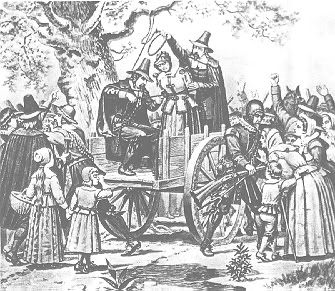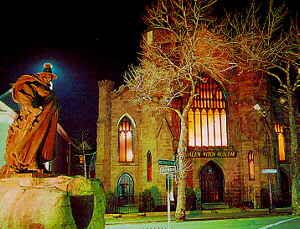Snapshots In My Time...
Of My Time.....Hauntings.
I just started reading Witch Child by Celia Rees. I have read about 20 pages and so far it is very intriguing. I have the same feeling when I was in middle school reading Salem's Lot by Stephen King for the very first time. I think it was an amazing thing, the power that women were perceived to have during those times. It is unfortunate that so many innocent women were persecuted in witch hunts.
Famous women in their time centered around witchcraft: Tituba
Tituba was an Indian woman, not (as commonly believed) a Negro slave. She was originally from an Arawak village in South America, where she was captured as a child, taken to Barbados as a captive, and sold into slavery. It was in Barbados that her life first became entangled with that of Reverend Samuel Parris. She was likely between the age of 12 and 17 when she came into the Parris household. She was most likely purchased by Parris from one of his business associates, or given to settle a debt. Parris, at the time, was an unmarried merchant, leading to speculation that Tituba may have served as his concubine.
Tituba helped maintain the Parris household on a day-to-day basis. When Parris moved to Boston in 1680, Tituba and another Indian slave named John accompanied him. Tituba and John were married in 1689 about the time the Parris family moved to Salem. It is believed that Tituba had only one child, a daughter named Violet, who would remain in Parris's household until his death.
Tituba made herself a likely target for witchcraft accusations when shortly after Parris's daughter, Betty, began having strange fits and symptoms, she participated in the preparation of a "witchcake" (a mixture of rye and Betty's urine, cooked and fed to a dog, in the belief that the dog would then reveal the identity of Betty's afflictor). Parris was enraged when he found out about the cake, and shortly thereafter the afflicted girls named Tituba as a witch. Parris beat her until she confessed.
Tituba was the first witch to confess in Salem, and she likely did it to avoid further punishment. In her confession she apologized for hurting Betty, claimed she never wanted to hurt Betty, and professed her love for the child. She also wove a lively tale of an active community of witches in Salem. She named Sarah Good and Sarah Osborne as witches. By confessing early on, Tituba avoided the ordeal of going to trial, joining with the afflicted girls in providing key evidence against accused witches. Her husband, John, would also fall into fits, and become afflicted.
When public sentiment towards the accusers and the trials began to change, Tituba recanted her confession. This further enraged Parris, who in retaliation, refused to pay the jailer's fee to get Tituba out a prison. As a result, she spent thirteen months in jail until an unknown person paid the seven pounds for her release and bought her. It is likely that the same person bought her husband, John, because Puritans were not inclined to split up married couples, even slaves. It is unknown what happened to her after she began her life with her new owner.

Bridget Bishop was first accused in 1680 for her husband death. It is not known if this was for
(1)Goodman Wasslebee's death or for
(2) Edward Bishop's death, but she was acquitted. She was, this time, accused on April 18, 1692 [12 years later]. Bridget was an innkeeper. She was accused of being a temptress in her red push-up bodice. By this time Bridgett was an elderly woman. Bridget was hanged on June 10, 1692. Bridget was married to husband three
(3)Edward Bishop. It was Edward that said she was a witch. They had no children.
Martha Cory: Martha Corey, unlike some of the others accused was a respected member of the community of more than "average judgement and discretion," and a member of the Village church. Prior to being named, she had steadfastly refused to give any credence to the witchcraft accusations, and when accused consistently denied any such associations.
Although her age is unknown, she was the third wife of Giles, and likely somewhat younger than he, but possibly more than sixty years of age at the time of the trials. Giles was eighty years of age at the time. Giles, at first taken up in the fury, appears to given a statement that might have contributed to his wife's discomfort. It was the testimony of others, however, that seems to have fully sealed her doom.
She was first examined in March, convicted on September 10, 1692 and hanged on September 22.
Tituba was an Indian woman, not (as commonly believed) a Negro slave. She was originally from an Arawak village in South America, where she was captured as a child, taken to Barbados as a captive, and sold into slavery. It was in Barbados that her life first became entangled with that of Reverend Samuel Parris. She was likely between the age of 12 and 17 when she came into the Parris household. She was most likely purchased by Parris from one of his business associates, or given to settle a debt. Parris, at the time, was an unmarried merchant, leading to speculation that Tituba may have served as his concubine.
Tituba helped maintain the Parris household on a day-to-day basis. When Parris moved to Boston in 1680, Tituba and another Indian slave named John accompanied him. Tituba and John were married in 1689 about the time the Parris family moved to Salem. It is believed that Tituba had only one child, a daughter named Violet, who would remain in Parris's household until his death.
Tituba made herself a likely target for witchcraft accusations when shortly after Parris's daughter, Betty, began having strange fits and symptoms, she participated in the preparation of a "witchcake" (a mixture of rye and Betty's urine, cooked and fed to a dog, in the belief that the dog would then reveal the identity of Betty's afflictor). Parris was enraged when he found out about the cake, and shortly thereafter the afflicted girls named Tituba as a witch. Parris beat her until she confessed.
Tituba was the first witch to confess in Salem, and she likely did it to avoid further punishment. In her confession she apologized for hurting Betty, claimed she never wanted to hurt Betty, and professed her love for the child. She also wove a lively tale of an active community of witches in Salem. She named Sarah Good and Sarah Osborne as witches. By confessing early on, Tituba avoided the ordeal of going to trial, joining with the afflicted girls in providing key evidence against accused witches. Her husband, John, would also fall into fits, and become afflicted.
When public sentiment towards the accusers and the trials began to change, Tituba recanted her confession. This further enraged Parris, who in retaliation, refused to pay the jailer's fee to get Tituba out a prison. As a result, she spent thirteen months in jail until an unknown person paid the seven pounds for her release and bought her. It is likely that the same person bought her husband, John, because Puritans were not inclined to split up married couples, even slaves. It is unknown what happened to her after she began her life with her new owner.

Bridget Bishop was first accused in 1680 for her husband death. It is not known if this was for
(1)Goodman Wasslebee's death or for
(2) Edward Bishop's death, but she was acquitted. She was, this time, accused on April 18, 1692 [12 years later]. Bridget was an innkeeper. She was accused of being a temptress in her red push-up bodice. By this time Bridgett was an elderly woman. Bridget was hanged on June 10, 1692. Bridget was married to husband three
(3)Edward Bishop. It was Edward that said she was a witch. They had no children.
Martha Cory: Martha Corey, unlike some of the others accused was a respected member of the community of more than "average judgement and discretion," and a member of the Village church. Prior to being named, she had steadfastly refused to give any credence to the witchcraft accusations, and when accused consistently denied any such associations.
Although her age is unknown, she was the third wife of Giles, and likely somewhat younger than he, but possibly more than sixty years of age at the time of the trials. Giles was eighty years of age at the time. Giles, at first taken up in the fury, appears to given a statement that might have contributed to his wife's discomfort. It was the testimony of others, however, that seems to have fully sealed her doom.
She was first examined in March, convicted on September 10, 1692 and hanged on September 22.

0 comments:
Post a Comment